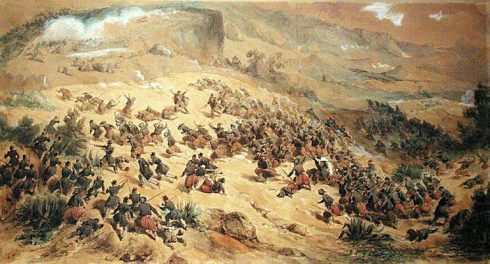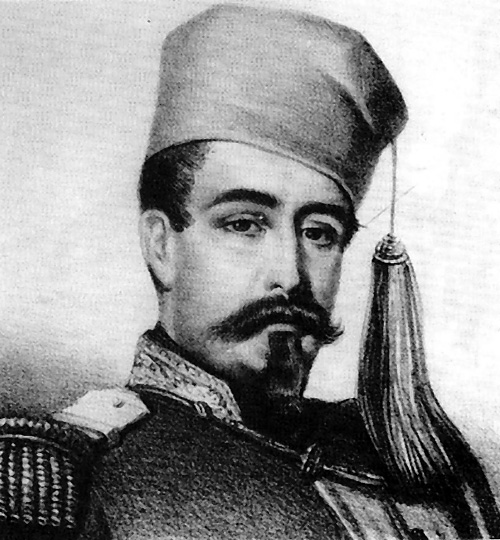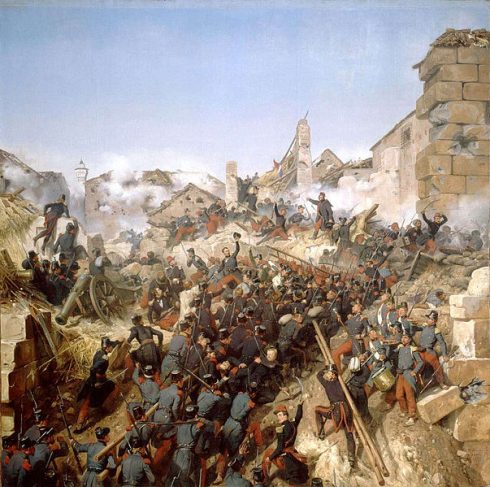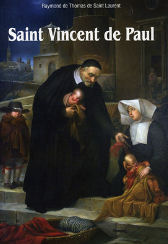Louis-Christophe-Leon Juchault de la Moricière
French general and commander-in-chief of the papal army, b. at Nantes, 5 February, 1806; d. at the château of Prouzel, near Amiens, 11 September, 1865. His father was descended from an old Breton family whose device was Spes mea Deus. His mother was Desirée de Robineau de Bougon. He made his classical studies at the college of Nantes, where his professor of philosophy was a priest who afterwards becane the Trappist Abbot of Bellefontaine. As had been the custom for centuries for the sons in his family, he was early destined for the army, and accordingly entered the Ecole Polytechnique, in Paris, in 1826, and two years later the Ecole d’Application at Metz. He left the latter school with a commission as sub-lieutenant in the engineers and was sent to Montpellier. In 1830 he joined the detachment that took possession of Algiers, and was made a captain of Zouaves as a reward for gallant conduct.
For seventeen years he remained in Africa, where he acquired a lasting reputation, acting not only as a valiant soldier, but as a pioneer of civilization, loved and esteemed by the Arabs as well as by his own soldiers. In 1833 he was directed by the French government to organize the “Bureau Arabe”, a sort of tribunal whose mission was to serve as mediator between Frenchmen and Arabs. His authority was so great among the native tribes that he never carried any arms while travelling through the country, but only a stick with which to defend himself, and this caused him to be named Bou-Aroua (father with a stick). After the capture of Bougie, he was promoted major and in 1835 lieutenant-colonel of Zouaves. In that capacity he took part in many a coup de main, inspiring his troops with indomitable courage, and always placing himself at the most perilous spot. His intrepidity at the storming of Constantine gained him the rank of colonel (1837). In 1840, after the engagement of Mouzaïa, he was raised to the rank of brigadier-general and was given the command of the division of Oran. In the following year he played a most prominent part in the expedition against Tagtempt and Mascara. Thanks to his skilful tactics and intrepidity, he subdued the tribe of Filtas (1843), and was created lieutenant-general. He next went to Morocco (1844), drove back the Moorish troops at Lalla-Maghnia, and contributed largely to the success of the battle at Isly (1845). Towards the end of that year, he was entrusted with the temporary governorship of Algeria. He then crowned his military career by surrounding Abd-el-Kader, who was compelled to surrender (23 November, 1847). Algeria being pacified, the distinguished soldier thought of retiring from military life and taking an active part in politics.
In 1846, having been elected deputy by the district of Saint-Calais (Sarthe), he had opposed the Guizot cabinet and created a stir by his speeches on Algeria and promotion in the army. On 21 April, 1847, he married Amélie d’Auberville. In February, 1848, he held for a few days the portfolio of war in the Thiers-Barrot cabinet, which he gave up when the Revolution burst out, causing the downfall of Louis Philippe. Having been elected to the Constituent Assembly (April, 1848) by the Department of Sarthe, he fought against the popular insurrection in June. On 28 June he again accepted the portfolio of war and directed all his efforts towards the organization of Algeria. When Louis Napoleon, to whose ambition he was strongly opposed, entered upon the presidency of the French Republic (20 December, 1848), he left the Cabinet and continued, as a deputy or as vice-president of the Assembly, to antagonize the Government. In the Coup d’Etat (2 December, 1852), he was arrested, imprisoned, first at Mazas, then at Ham, and finally expelled from France. His political career had lasted only four years; his exile lasted nine years. This was the most distressing period of his life. He first travelled in England and Germany and then settled in Belgium pining in his enforced idleness, and longing for active occupation. It was then that he came back to the faith of his youth. For many years, without being an infidel, he had neglected his religious duties, and even for a time had gone astray with the Saint-Simonians. Yielding to the entreaties of his friend Charles de Montalembert, the great Catholic orator, he began to study one by one all the articles of the Credo. From that time to the day of his death he lived according to his faith as a devout Catholic.

Battle at Mouzaïa, May 12, 1840 by the Zouaves and infantrymen of Vincennes under the command of Colonel de La Moriciere.
In 1860 his cousin, Mgr. de Mérode, induced him to take command of the papal army. It was a hazardous task. Ignoring the jeopardy of his established military reputation, he went to Rome. It took only one year to convince him that the undertaking was hopeless. His 8000 men were defeated by the 50,000 men of Cialdini at Castelfidardo (18 September, 1860), and Ancona was obliged to surrender. He bore this severe blow to his reputation with Christian resignation. Deeming his services no longer useful to the papal army, he returned to France, and went to live in his château of Chaillon (Maine-et-Loire). A national subscription was collected to present him with a sword of honour, but he emphatically declined to receive it, on the ground that he was only a defeated general. The only distinction he ever accepted, under personal pressure from Pope Pius IX, was the Cross of the Order of Christ.
His last years were devoted to pious works. He built a church at his own expense for the poor parish of Loroux-Beconnais, and contributed large sums to an orphanage and a Catholic school which he had founded. He took pleasure in reading religious books, among which the Holy Bible, the “Summa Theologica” of Saint Thomas, and the “History of the Church” by Darras, were his favourites. When the encyclical letter of 8 December, 1864, was published, he read it with delight, being happy to find in it an answer to many questions which distressed him. His death was sudden. His name is now extinct, as he left only daughters, having lost his only son in 1859, but his fame will last forever as that of a gallant soldier and a true Christian.
Oraisons funebres de La Moricière, by PIE (Poitiers, 1865) and DUPANLOUP (Orleans. 1865); KELLER, Le General de La Moricière (2 vols., Paris, 1874); HUGNET, Celebres conversions contemporaines (Paris, 1889); BAUNARD, La foi et ses victoires (Paris, 1892).
LOUIS N. DELAMARRE (Catholic Encyclopedia)




















